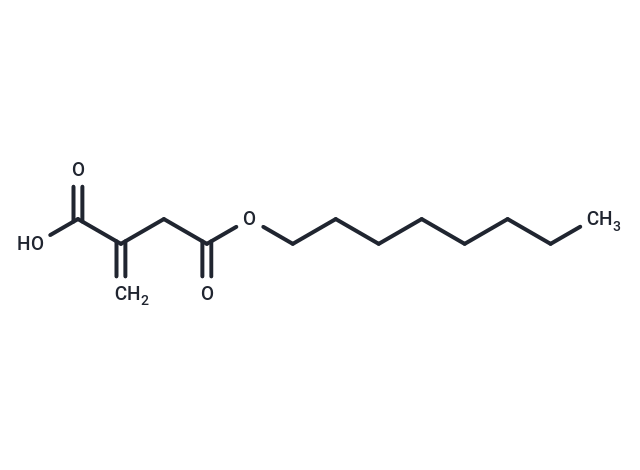Shopping Cart
Remove All Your shopping cart is currently empty
Your shopping cart is currently empty
4-Octyl Itaconate, a cell-permeable derivative of Itaconate, is an anti-inflammatory metabolite that activates Nrf2 via alkylation of KEAP1 and inhibits phosphorylation of STING.

| Pack Size | Price | USA Warehouse | Global Warehouse | Quantity |
|---|---|---|---|---|
| 25 mg | $30 | In Stock | In Stock | |
| 50 mg | $40 | In Stock | In Stock | |
| 100 mg | $58 | In Stock | In Stock | |
| 1 mL x 10 mM (in DMSO) | $44 | In Stock | In Stock |
| Description | 4-Octyl Itaconate, a cell-permeable derivative of Itaconate, is an anti-inflammatory metabolite that activates Nrf2 via alkylation of KEAP1 and inhibits phosphorylation of STING. |
| In vitro | METHODS: Human PBMC cells were pretreated with 4-Octyl Itaconate (62.5-125 μM) for 3 h. The expression levels of target proteins were detected by Western Blot. RESULTS: 4-Octyl Itaconate decreased LPS-induced pro-IL-1β and HIF-1α protein levels. [1] METHODS: Macrophage THP1 cells were treated with 4-Octyl Itaconate (200 ng/mL) for 2 h, then stimulated with 2′,3′cGAMP for 1 h. The level of p-STING was detected by Immunofluorescence. RESULTS: 4-Octyl Itaconate pretreatment resulted in a significant inhibition of STING phosphorylation. [2] |
| In vivo | METHODS: To test the anti-inflammatory activity in vivo, 4-Octyl Itaconate (50 mg/kg in 40% cyclodextrin in PBS) was intraperitoneally injected into mice, and 2 h later LPS (2.5 mg/kg) was intraperitoneally injected. RESULTS: 4-Octyl Itaconate counteracted the pro-inflammatory response to LPS in vivo. 4-Octyl Itaconate activated Nrf2, prolonged survival, decreased clinical scores and improved thermoregulation, and decreased IL-1β and TNF levels, but not IL-10, in the LPS model of sepsis. [1] METHODS: To investigate the role in immunosuppressive impairment in sepsis, 4-Octyl Itaconate (25-50 mg/kg) was injected intraperitoneally into a C57bl/6 mouse model of sepsis established by cecum ligation and puncture (CLP). RESULTS: 4-Octyl Itaconate inhibits the early release of inflammatory and oxidative stress-related factors to reduce tissue and organ damage in septic mice. [3] |
| Molecular Weight | 242.31 |
| Formula | C13H22O4 |
| Cas No. | 3133-16-2 |
| Smiles | C(CC(C(O)=O)=C)(OCCCCCCCC)=O |
| Relative Density. | 1.026 g/cm3 (Predicted) |
| Color | White |
| Appearance | Solid |
| Storage | keep away from direct sunlight,store under nitrogen,store at low temperature | Powder: -20°C for 3 years | In solvent: -80°C for 1 year | Shipping with blue ice/Shipping at ambient temperature. | |||||||||||||||||||||||||||||||||||
| Solubility Information | DMSO: 237.5 mg/mL (980.15 mM), Sonication is recommended. | |||||||||||||||||||||||||||||||||||
| In Vivo Formulation | 10% DMSO+40% PEG300+5% Tween 80+45% Saline: 12.2 mg/mL (50.35 mM), Solution. Please add the solvents sequentially, clarifying the solution as much as possible before adding the next one. Dissolve by heating and/or sonication if necessary. Working solution is recommended to be prepared and used immediately. The formulation provided above is for reference purposes only. In vivo formulations may vary and should be modified based on specific experimental conditions. | |||||||||||||||||||||||||||||||||||
Solution Preparation Table | ||||||||||||||||||||||||||||||||||||
DMSO
| ||||||||||||||||||||||||||||||||||||
| Size | Quantity | Unit Price | Amount | Operation |
|---|

Copyright © 2015-2025 TargetMol Chemicals Inc. All Rights Reserved.